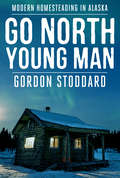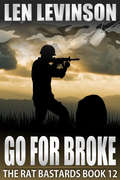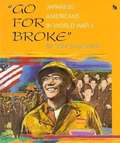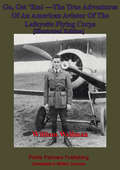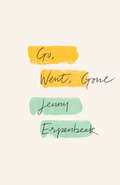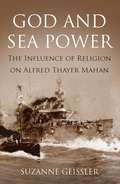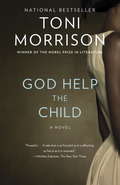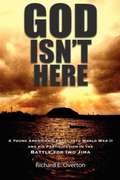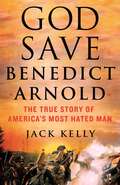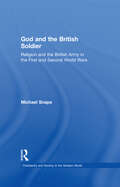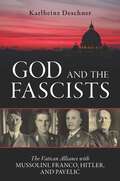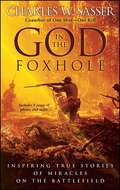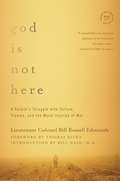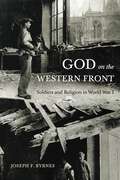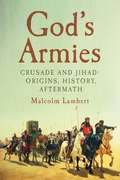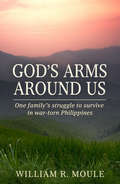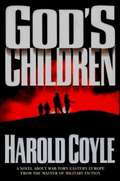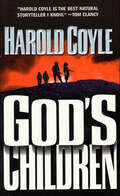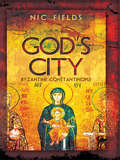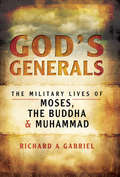- Table View
- List View
Go North, Young Man: Modern Homesteading in Alaska
by Gordon StoddardGo North, Young Man, first published in 1957, is Gordon Stoddard's account of his first four years as a homesteader on Alaska's Kenai peninsula in the 1950s. From building his first cabin (with only the aid of a basic do-it-yourself pamphlet), to growing an abundance of over-sized vegetables, to hunting and foraging and surviving the long winters, Stoddard portrays a down-to-earth look at the simple life he desired and created for himself. Includes 19 pages of photographs and maps.
Go for Broke: Go For Broke (The Rat Bastards Series #12)
by Len LevinsonThe twisted trail of blood! Slicing and stabbing hand-to-hand for the bloody booty of war. Ramming a hijacked truck through the hell of enemy lines. Escaping over water made choppy by hot Japanese bullets. Defending a cave full of frightened American nurses from a brutal onslaught of killers. The Rat Bastards fight on, turning New Guinea into an island of savage slaughter. They'll take on their own top brass, ten roll flat the whole Jap army. For them, war isn't everything. It's the only thing. The Rat Bastards.
Go for Broke: Japanese Americans in World War II (First Bks.)
by Tom McGowenDetailed accounts of Japanese-Americans serving in World War II.
Go! Go! Go!: The Definitive Inside Story of the Iranian Embassy Siege
by Will Pearson Rusty FirminThe first comprehensive account of the storming of the Iranian Embassy in London in 1980.GO! GO! GO! tells the action-packed story of the 1980 Iranian Embassy siege. It is a comprehensive, detailed and gripping account of an unforgettable six-day drama that shook Britain -- and the wider world -- to the core. Drawing on original and unseen source material from ex-SAS soldier Rusty Firmin, the police and the British Government, GO! GO! GO! takes us to the heart of the whole operation.The assault planning and training, strategy and tactics are described in detail, and the personal stories of the gunmen revealed -- who they were, where they came from, why they did it and Saddam Hussein's direct involvement. Compelling accounts of each day of the siege from the hostages' points of view show how they dealt with captivity individually and collectively. New material explains the negotiators' tactics and their cool exterior versus their internal turmoil as negotiations reached crisis point.
Go! Go! Go!: The Definitive Inside Story of the Iranian Embassy Siege
by Will Pearson Rusty FirminThe first comprehensive account of the storming of the Iranian Embassy in London in 1980.GO! GO! GO! tells the action-packed story of the 1980 Iranian Embassy siege. It is a comprehensive, detailed and gripping account of an unforgettable six-day drama that shook Britain -- and the wider world -- to the core. Drawing on original and unseen source material from ex-SAS soldier Rusty Firmin, the police and the British Government, GO! GO! GO! takes us to the heart of the whole operation.The assault planning and training, strategy and tactics are described in detail, and the personal stories of the gunmen revealed -- who they were, where they came from, why they did it and Saddam Hussein's direct involvement. Compelling accounts of each day of the siege from the hostages' points of view show how they dealt with captivity individually and collectively. New material explains the negotiators' tactics and their cool exterior versus their internal turmoil as negotiations reached crisis point.
Go, Get ‘Em! —The True Adventures Of An American Aviator Of The Lafayette Flying Corps - [Illustrated Edition]: Who Was The Only Yankee Flyer Fighting Over General Pershing’s Boys Of The Rainbow Division In Lorraine
by William Augustus Wellman"The adventures of a renowned American fighter pilot-in his own wordsAfter initially enlisting as an ambulance driver during the Great War, American born Wellman transferred into the French Foreign Legion. By the end of 1917 he had earned his wings as a fighter pilot and had joined N. 87 escadrille of the Lafayette Flying Corps. The 'Black Cats' flew Nieuport 'pursuit' aircraft-first 17s and latterly 24s. Wellman named his own plane Celia-after his mother. In his career as a fighter pilot Wellman chalked up three confirmed 'kills' and five 'probables' before eventually being shot down by German anti-aircraft fire in March 1918. He was awarded the Croix de Guerre with two palms. Due to his crash injury he was invalided out of French service and returned to the United States where he began a highly regarded career as a film director. This book, published in 1918, recounts Wellman's wartime experiences while they were still fresh in the mind, as such it is an invaluable first-hand account of the aerial war over the Western Front from the first days of air combat. Recommended."--Leonaur Print VersionAuthor -- Wellman, William Augustus, 1896-1975Text taken, whole and complete, from the edition published in Boston, The Page company, 1918Original Page Count - 284 pagesIllustration -- 16 illustrations.
Go, Went, Gone
by Jenny Erpenbeck Susan BernofskyGo, Went, Gone is the masterful new novel by the acclaimed German writer Jenny Erpenbeck. The novel tells the tale of Richard, a retired classics professor who lives in Berlin. His wife has died, and he lives a routine existence until one day he spies some African refugees staging a hunger strike in Alexanderplatz. Curiosity turns to compassion and an inner transformation, as he visits their shelter, interviews them, and becomes embroiled in their harrowing fates. <p><p> Go, Went, Gone is a scathing indictment of Western policy toward the European refugee crisis, but also a touching portrait of a man who finds he has more in common with the Africans than he realizes. Exquisitely translated by Susan Bernofsky, Go, Went, Gone addresses one of the most pivotal issues of our time, facing it head-on in a voice that is both nostalgic and frightening.
God And Sea Power: The Influence Of Religion On Alfred Thayer Mahan
by Suzanne GeisslerThis book focuses on the religious beliefs and writings of naval historian and theorist Alfred Thayer Mahan. Mahan was a devout Christian and an active Episcopal layman. His religious beliefs had a major influence on his theories of sea power, naval command, war, and politics. Some historians and biographers have completely ignored his these beliefs. Others have acknowledged them, but viewed them as irrelevant to Mahan’s thinking on naval matters. Some have acknowledged them as important, but viewed them as being a negative influence on Mahan. All these views are wrong. Mahan devoted a lifetime to studying and developing his views on religion and they were a major source of his thinking on his naval and political theories. And his religious writings also demonstrate that many of the negative stereotypes of him (such as imperialist, war-monger, racist, Social Darwinist) are inaccurate. There is a large body of material that has either been overlooked or only superficially studied that give us insight into Mahan’s religious life, thoughts, and writings. There is a large collection of correspondence to family and friends in which Mahan discuses his Christian faith. There is his diary, kept while he was a young officer on a three-year voyage aboard the USS Iroquois. This document, also frequently misunderstood, gives a dramatic account of his struggles to achieve a right relationship with God. Lastly, there is a significant corpus of his published writings on religious topics. Once he retired from the Navy Mahan began to publish extensively on theological topics in both the secular and religious press. These writings included letters to the editor, book reviews, articles, and a book, The Harvest Within: Thoughts on the Life of a Christian published in 1909. In addition to his writings he also gave a number of speeches to church groups. Copies of most of these speeches still exist. All this material gives us a very full picture of his faith, a fascinating combination of born-again evangelicalism and High Church Anglicanism. Mahan was also an active layman in the Episcopal Church and these activities are discussed as well. Mahan’s father, Dennis Hart Mahan, was a West Point professor of engineering and military science for many years, and was a notable military figure in his own right. Mahan’s uncle, Milo Mahan, was a noted church historian and professor at General Theological Seminary. Both these men had a strong influence on Alfred and their lives and careers are discussed as well.
God Help the Child
by Toni MorrisonThe new novel from Nobel laureate Toni Morrison.Spare and unsparing, God Help the Child is a searing tale about the way childhood trauma shapes and misshapes the life of the adult. At the centre: a woman who calls herself Bride, whose stunning blue-black skin is only one element of her beauty, her boldness and confidence, her success in life; but which caused her light-skinned mother to deny her even the simplest forms of love until she told a lie that ruined the life of an innocent woman, a lie whose reverberations refuse to diminish.... Booker, the man Bride loves and loses, whose core of anger was born in the wake of the childhood murder of his beloved brother ... Rain, the mysterious white child, who finds in Bride the only person she can talk to about the abuse she's suffered at the hands of her prostitute mother ... and Sweetness, Bride's mother, who takes a lifetime to understand that "what you do to children matters. And they might never forget."
God Is a Grunt: And More Good News for GIs
by Logan M IsaacThis eye-opening book invites readers of all political and denominational stripes into a more meaningful conversation and community with soldiers and veterans. If Jesus is God, then God is a grunt—the humble, hardy folk placed at the bottom of the social hierarchy who are relied on to accomplish the dirtiest, most difficult (and most thankless) work. This is good news for millions of Christian soldiers and veterans in the U.S. because they have had to make an impossible choice, with no perceivable middle ground, between patriot and pacifist. In his new book, God Is a Grunt, Logan Isaac offers an opportunity for GIs, veterans, and those close to them to read Christian traditions as a soldier would—by and through the lived experiences of military service. This well-researched, meditative guide for Christians who have served their country delves deep into the Bible, while Isaac shares his own beliefs and thoughts on the life-altering experiences of battle. He attempts to fill the void most Christians in the military feel by providing theological resources to discern a better way of discipleship for GIs, affirming the nuance and complexity of armed service and the gifts GIs extend to Christians around the world.
God Isn't Here: A Young Man's Entry into World War II and His Participation in the Battle for Iwo Jima
by Richard E. OvertonWith attention to detail only an eyewitness can offer, Overton's gut-wrenching memoir of the battle at Iwo Jima captures the insufferable horrors of combat at the greatest battle of the modern era.
God Save Benedict Arnold: The True Story of America's Most Hated Man
by Jack KellyFinalist, New England Book Awards"Vivid." —The Wall Street Journal"A dazzling addition to the history of the American Revolution." ―Kirkus Review (starred)"Finally... a full and fascinating portrait of a true hero of the American Revolution, until he was visited by villainy. A riveting read." ―Tom Clavin, New York Times bestselling author of Follow Me to HellBenedict Arnold committed treason— for more than two centuries, that’s all that most Americans have known about him.Yet Arnold was much more than a turncoat—his achievements during the early years of the Revolutionary War defined him as the most successful soldier of the era. GOD SAVE BENEDICT ARNOLD tells the gripping story of Arnold’s rush of audacious feats—his capture of Fort Ticonderoga, his Maine mountain expedition to attack Quebec, the famous artillery brawl at Valcour Island, the turning-point battle at Saratoga—that laid the groundwork for our independence.Arnold was a superb leader, a brilliant tactician, a supremely courageous military officer. He was also imperfect, disloyal, villainous. One of the most paradoxical characters in American history, and one of the most interesting. GOD SAVE BENEDICT ARNOLD does not exonerate him for his treason—the stain on his character is permanent. But Kelly’s insightful exploration of Arnold’s career as a warrior shines a new light on this gutsy, fearless, and enigmatic figure. In the process, the book offers a fresh perspective on the reasons for Arnold’s momentous change of heart.
God and the British Soldier: Religion and the British Army in the First and Second World Wars (Christianity and Society in the Modern World)
by Michael SnapeDrawing on a wealth of new material from military, ecclesiastical and secular civilian archives, Michael Snape presents a study of the experience of the officers and men of Britain’s vast citizen armies, and also of the numerous religious agencies which ministered to them. Historians of the First and Second World Wars have consistently underestimated the importance of religion in Britain during the war years, but this book shows that religion had much greater currency and influence in twentieth-century British society than has previously been realised. Snape argues that religion provided a key component of military morale and national identity in both the First and Second World Wars, and demonstrates that, contrary to accepted wisdom, Britain’s popular religious culture emerged intact and even strengthened as a result of the army’s experiences of war. The book covers such a range of disciplines, that students and scholars of military history, British history and Religion will all benefit from its purchase.
God and the Fascists: The Vatican Alliance with Mussolini, Franco, Hitler, and Pavelic
by Karlheinz DeschnerNow available in English for the first time, a controversial work that indicts the Vatican for its actions before and during World War II. In the decade preceding the outbreak of World War II, the Vatican made a devil's bargain with fascist leaders. Anticipating that their regimes would eliminate a common enemy—namely Marxist-Leninist communism—two popes essentially collaborated with Hitler, Mussolini, and the fascist dictators in Spain (Franco) and Croatia (Pavelić). This is the damning indictment of this well-researched polemic, which for almost five decades in Germany has sparked controversy, outrage, and furious debate. Now it is available in English for the first time. Many will dismiss Deschner—who himself was raised and educated in a pious Catholic tradition—as someone who is obsessed with exposing the failings of the church of his upbringing. But he has marshaled so many facts and presented them with such painstaking care that his accusations cannot easily be ignored. The sheer weight of the evidence that he has brought together in this book raises a host of questions about a powerful institution that continues to exercise political influence to this day.
God in the Foxhole: Inspiring True Stories of Miracles on the Battlefield
by Charles W. SasserFrom veteran military writer Charles Sasser comes a collection of inspiring personal accounts of American soldiers whose faith has guided them through the hardships of war.From the battlefields of the American Civil War through World Wars I and II, from Korea and Vietnam to the front lines in Iraq and Afghanistan, soldiers of all faiths have struggled for understanding and called on a higher power when faced with the realities of combat. God in the Foxhole is a stunning collection of true personal accounts from generations of American soldiers whose faith, in the words of author Charles W. Sasser, "has been born, reborn, tested, sustained, verified, or transformed under fire." A renowned master of combat journalism and a former Green Beret, Sasser has gathered an immensely moving collection of war stories like no other—stories of spirituality, conversion, and miracles from the battlefield. Be they Christian, Jewish, Muslim, or atheist, churched since childhood or touched by the divine for the first time, here are the riveting experiences of army privates, bomber pilots, navy lieutenants, marines, prisoners of war, medics, nurses, chaplains, and others who, under desperate circumstances and with every reason to fear for their lives, found unknown strength, courage, and heroism through their remarkable faith. These inspiring accounts transcend the explainable to become stunning portraits of survival and belief: the angelic vision that brought inner peace to an exhausted helicopter door gunner in Vietnam; the makeshift full-immersion baptisms of eleven soldiers on Palm Sunday in Iraq, 2004; two enemies—a Nazi priest and an American G.I.—who served Communion Mass in a Belgian sanctuary in 1944; the prescient letter from a Civil War army major to his beloved wife, one week before his death at Bull Run; the 21st-century toddler with a jaw-dropping spiritual connection to a war hero of Iwo Jima, and dozens more. A war chronicle like no other, God in the Foxhole affirms, for military buffs and readers from all walks of life, the power of faith in the face of adversity.
God is Not Here: A Soldier's Struggle with Torture, Trauma, and the Moral Injuries of War
by Thomas Ricks Bill Nash Lieutenant Colonel Edmonds George LoberGod Is Not Here is a powerful and intimate look into torture and its effect on both the tortured and the torturer. In May of 2005, the U.S. government finally acknowledged that the invasion of Iraq had spawned an insurgency. With that admission, training the Iraqi Forces suddenly became a strategic priority. Lt. Col. Bill Edmonds, then a Special Forces captain, was in the first group of "official" military advisors. He arrived in Mosul in the wake of Abu Ghraib, at the height of the insurgency, and in the midst of America's rapidly failing war strategy. Edmonds' job was to advise an Iraqi intelligence officer--to assist and temper his interrogations--but not give orders. But he wanted to be more than a wallflower, so he immersed himself in the experience, even learning Arabic. In a makeshift basement prison, over countless nights and predawn hours, Edmonds came to empathize with Iraqi rules: do what's necessary, do what works. After all, Americans and Iraqis were dying. Edmonds wanted to make a difference. Yet the longer he submerged himself in the worst of humanity, the more conflicted and disillusioned he became, slowly losing faith in everything and everyone. In the end, he lost himself. He returned home with no visible wounds, but on the inside he was different. He tried to forget--to soldier on--but memories from war never just fade away... In God Is Not Here, the weight of history is everywhere, but the focus is on a young man struggling to learn what is right when fighting wrong. Edmonds provides a disturbing and thought-provoking account of the morally ambiguous choices faced when living with and fighting within a foreign religion and culture, as well as the resulting psychological and spiritual impacts on a soldier. Transcending the genre of the traditional war memoir, Edmonds' eloquent recounting makes for one of the most insightful and moving books to emerge from America's long war against terrorism.
God of Vengeance: (The Rise of Sigurd 1): A thrilling, action-packed Viking saga from bestselling author Giles Kristian (Sigurd #1)
by Giles KristianA glorious, bloody, perfect Viking saga of honour, courage, blood feud and revenge from the Sunday Times bestselling author of Lancelot, Giles Kristian. Perfect for fans of Bernard Cornwell and Games of Thrones."Unrelenting pace, brilliant action and characters. A masterwork." - CONN IGGULDEN"Action-packed storytelling which stirs the blood and thrills the soul" - WILBUR SMITH"Easily one of the best books I've had the pleasure to read" - ***** Reader review.*******************************************************************************IT BEGAN WITH THE BETRAYAL OF A LORD BY A KING...Norway 785 AD. When King Gorm puts Jarl Harald's family to the sword, he makes one fatal mistake - he fails to kill Harald's youngest son, Sigurd.His kin slain, his village seized, his taken as slaves, Sigurd wonders if the gods have forsaken him. Hunted by powerful men, he is unsure who to trust and yet he has a small band of loyal followers at his side. With them - and with the help of the All-Father, Odin - he determines to make a king pay for his treachery.Using cunning and war-craft, Sigurd gathers together a fellowship of warriors - including his father's right-hand man Olaf, Bram (who men call Bear), Black Floki who wields death with a blade, and the shield maiden Valgerd, who fears no man - and convinces them to follow him. For, whether Ódin is with him or not, Sigurd WILL have vengeance. And neither men nor gods had best stand in his way . . .Sigurd's story continues in Winter's Fire.
God on the Western Front: Soldiers and Religion in World War I
by Joseph F. ByrnesFrom 1914 to 1918, religious believers and hopeful skeptics tried to find meaning and purpose behind divinely willed destruction. God on the Western Front is a history of lived religion across national boundaries, religious affiliations, and class during World War I, utilizing an expansive record of primary sources.Joseph F. Byrnes takes readers on a tour of the battlefields of France, listening to the words of German, French, and English soldiers; going behind the lines to hear from the men and women who provided pastoral and medical care; and reviewing the religious writings of priests, bishops, ministers, and rabbis as they tried to make sense of it all. The story begins with citizens at home as they responded to the obligation to make war and then focuses on the “God-talk” and “nation-talk” that soldiers used to express their foundational religious experiences. Byrnes’s study attends to the words of average men who struggled to articulate their religious sentiments, alongside the generals Helmuth von Moltke, Ferdinand Foch, and Douglas Haig and the soldier theologians Franz Rosenzweig, Paul Tillich, Pierre Teilhard de Chardin, and Geoffrey Studdert Kennedy. In doing so, he shows how religious and battle experience are intertwined and showcases the wide range of spiritual responses that emerged across boundaries.Going beyond the typical constraints of studies focused either on one nation or one confessional affiliation, Byrnes’s international and interfaith approach breaks new ground. It will appeal to scholars and students of modern European history, religious history, and the history of war.
God's Armies: Origins, History, Aftermath
by Malcolm LambertWith ramifications on geopolitics today, a vivid chronicle of the Christian and Islamic struggle to control the sacred places of Palestine and the Middle East between the seventh and thirteenth centuries. Crusade and jihad are often reckoned to have represented two sides of the same coin: each resonated on the opposing sides in the holy wars of the Middle Ages and each has been invoked during the war on terror. A chronicle of the Christian and Islamic struggle to control the sacred places of Palestine and the Middle East between the seventh and thirteenth centuries, this dynamic new history demonstrates that this simple opposition ignores crucial differences. Placing an equal emphasis on the inner histories of Christianity and Islam, the book traces the origins and development of crusade and jihad, showing for example that jihad reflected internal tensions in Islam from its beginnings. The narrative also reveals the ways in which crusade and jihad were used to disguise ambitions for power and to justify atrocity and yet also inspired acts of great chivalry and heroic achievement. The story brims with larger than life characters, among them Richard the Lionheart, Nur al-Din, Saladin, Baybars, and Ghengiz Khan. Lambert concludes by considers the long after-effects of jihad and crusade, including the role of the latter in French imperialism and of the former in the wars now afflicting the Middle East and parts of Africa. This vivid, balanced account will interest all readers who wish to understand the complexities of the medieval world and how it relates our own.
God's Arms Around Us
by William R. MouleGod's Arms Around Us, first published in 1960, is author William Moule's account of his and his family's harrowing 3-1/2 years in the Philippines during the Second World War. Moule, an American miner working in the Philippines, his wife (who was expecting a baby), and their two young children found themselves caught up in the brutal conflict being waged by the occupying Japanese. Rather than go into an internment camp - and believing that the war would soon be over - the Moules attempted to find refuge in the mountainous terrain of Luzon. However, the Moules were forced to be continually on the move, climbing mountains, fording streams, hiking through unfamiliar terrain at night, with an ever-present threat from roving enemy patrols. Yet through it all, William Moule maintained his strong faith in God ('He would keep His arms around them') and his Irish sense of humor. His wife, Marge, very seldom failed to smile with him. By 1943, however, severely weakened by malaria, the family could no longer stay on the run. Captured, they were taken first to Japanese garrisons, then to Camp Holmes, and later to the infamous Bilibid Prison in Manila. While imprisoned, Moule was tortured in an attempt to uncover his presumed part in guerrilla activities. Finally, the Moules and other prisoners were freed by American soldiers, and make their way back to the United states. "Marge and I," said William Moule, "brought three little kids through an ordeal that most single men couldn't survive, but we had the will to survive, and we had faith." Sadly, William and Marge Moule were killed in a car accident in Nevada in 1989, leaving behind their now large family of 12 children.
God's Children
by Harold CoyleA tale of high-tech warfare set in the near future, this is the story of the 3rd Platoon, C Company, 2nd Battalion of the 13th Infantry, and 2 young officers who attempt to keep the peace.
God's Children (Nathan Dixon #1)
by Harold Coyle“The modern master of life-under-combat [delivers] an engrossing, uncompromisingly suspenseful tale” of high-tech warfare (Kirkus Reviews).As the Good Book says, “Blessed are the Peace Keepers, for they will be called God’s Children.” Yet for American soldiers deployed to warzones on foreign soil, peacekeeping is not child’s play. In this action-filled technothriller, author and military expert Harold Coyle examines some of the most pressing issues facing today’s soldiers.When ethnic tensions in near-future Slovakia reach a boiling point, the US Army sends troops to join a NATO force in the region. God’s Children tells the story of 3rd Platoon, C Company, 2nd Battalion of the 13th Infantry, and two young officers who try to keep a peace that is falling apart before their very eyes.
God's City: Byzantine Constantinople
by Nic FieldsByzantium. Was it Greek or Roman, familiar or hybrid, barbaric or civilized, Oriental or Western? In the late eleventh century Constantinople was the largest and wealthiest city in Christendom, the seat of the Byzantine emperor, Christs vice-regent on earth, and the center of a predominately Christian empire, steeped in Greek cultural and artistic influences, yet founded and maintained by a Roman legal and administrative system. Despite the amalgam of Greek and Roman influences, however, its language and culture was definitely Greek. Constantinople truly was the capital of the Roman empire in the East, and from its founding under the first Constantinus to its fall under the eleventh and last Constantinus the inhabitants always called themselves Romaioi, Romans, not Hellniks, Greeks. Over its millennium long history the empire and its capital experienced many vicissitudes that included several periods of waxing and waning and more than one golden age.Its political will to survive is still eloquently proclaimed in the monumental double land walls of Constantinople, the greatest city fortifications ever built, on which the forces of barbarism dashed themselves for a thousand years. Indeed, Byzantium was one of the longest lasting social organizations in history. Very much part of this success story was the legendary Varangian Guard, the lite body of axe-bearing Northmen sworn to remain loyal to the true Christian emperor of the Romans. There was no hope for an empire that had lost the will to prosecute the grand and awful business of adventure. The Byzantine empire was certainly not of that stamp.
God's Fury, England's Fire: A New History of the English Civil Wars
by Michael BraddickThe sequence of civil wars that ripped England apart in the seventeenth century was the single most traumatic event in this country between the medieval Black Death and the two world wars. Indeed, it is likely that a greater percentage of the population were killed in the civil wars than in the First World War. This sense of overwhelming trauma gives this major new history its title: God’s Fury, England’s Fire. The name of a pamphlet written after the king’s surrender, it sums up the widespread feeling within England that the seemingly endless nightmare that had destroyed families, towns and livelihoods was ordained by a vengeful God – that the people of England had sinned and were now being punished. As with all civil wars, however, ‘God’s fury’ could support or destroy either side in the conflict. Was God angry at Charles I for failing to support the true, protestant, religion and refusing to work with Parliament? Or was God angry with those who had dared challenge His anointed Sovereign?Michael Braddick’s remarkable book gives the reader a vivid and enduring sense both of what it was like to live through events of uncontrollable violence and what really animated the different sides. The killing of Charles I and the declaration of a republic – events which even now seem in an English context utterly astounding – were by no means the only outcomes, and Braddick brilliantly describes the twists and turns that led to the most radical solutions of all to the country’s political implosion. He also describes very effectively the influence of events in Scotland, Ireland and the European mainland on the conflict in England.God’s Fury, England’s Fire allows readers to understand once more the events that have so fundamentally marked this country and which still resonate centuries after their bloody ending.
God's Generals: The Military Lives of Moses, the Buddha & Muhammad
by Richard A. GabrielIt is one of the more startling facts of military history that the founders of three of the four 'great religions'—Judaism, Buddhism, and Islam—were also accomplished field generals with extensive experience in commanding men in battle. One of these, Muhammad, fought eight battles and was wounded twice, once almost fatally. Another, Siddhartha Gautama (later to become the Buddha), witnessed so much battlefield carnage that he suffered a psychological collapse. Moses had become so much a 'god-intoxicated' personality, it is a reasonable suspicion that he, like the Buddha, was murdered. Indeed, had the experiences of these men in war not been so successful, it is quite possible that their achievements as religious leaders would never have occurred. For all three, war and religion were so closely intertwined in their personalities that it is difficult to discern where the influence of one ended and the other began. This book attempts to explore the military lives of Moses, the Buddha and Muhammad, and the role their war experiences played in their religious lives.
